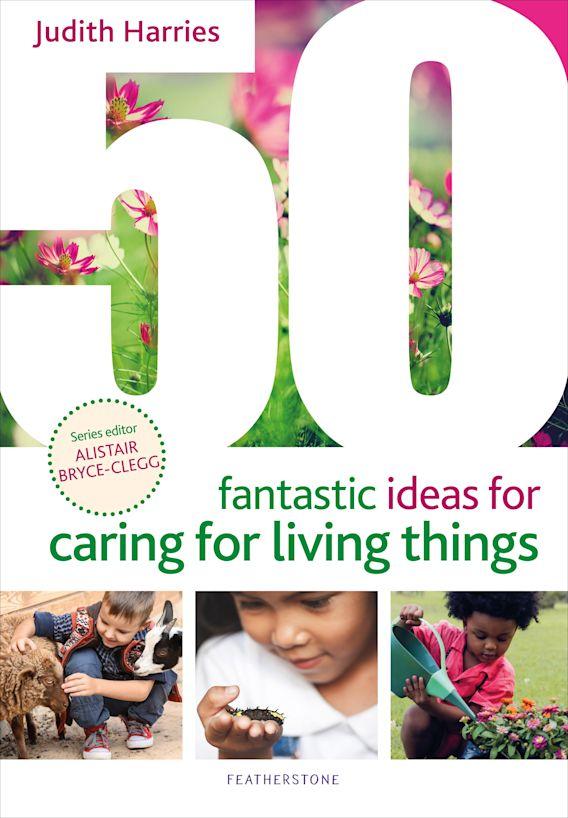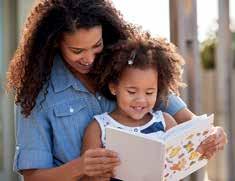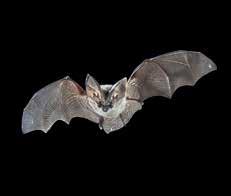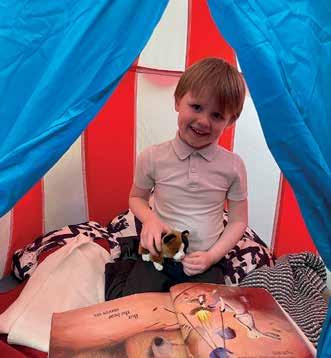

FEATHERSTONE
Bloomsbury Publishing Plc 50 Bedford Square, London, WC1B 3DP, UK 29 Earlsfort Terrace, Dublin 2, Ireland
BLOOMSBURY, FEATHERSTONE and the Feather logo are trademarks of Bloomsbury Publishing Plc
First published in Great Britain, 2022 by Bloomsbury Publishing Plc This edition published in Great Britain, 2022 by Bloomsbury Publishing Plc
Text copyright © Judith Harries, 2022
Photographs © Bloomsbury Publishing Plc, 2022 / © Arundel CofE Primary School, 2022 / © Shutterstock, 2022
Judith Harries has asserted her right under the Copyright, Designs and Patents Act, 1988, to be identified as Author of this work
Bloomsbury Publishing Plc does not have any control over, or responsibility for, any third-party websites referred to or in this book. All internet addresses given in this book were correct at the time of going to press. The author and publisher regret any inconvenience caused if addresses have changed or sites have ceased to exist, but can accept no responsibility for any such changes
All rights reserved. No part of this publication may be reproduced or transmitted in any form or by any means, electronic or mechanical, including photocopying, recording, or any information storage or retrieval system, without prior permission in writing from the publishers
A catalogue record for this book is available from the British Library
ISBN: PB: 978-1-8019-9047-9; ePDF: 978-1-8019-9048-6 2 4 6 8 10 9 7 5 3 1
Series design by Lynda Murray Design by Jeni Child
Printed and bound in India by Replika Press Pvt. Ltd
To find out more about our authors and books visit www.bloomsbury.com and sign up for our newsletters
Introduction .................................................. 4
Animal magic
Living and non-living things ......................... 6 Scavenger hunt 8 Night and day 9
Hibernating hints 10 Clever camouflage 11
Pets and domestic animals

Pet pie chart .............................................. 12 I want a pet ................................................ 13 Pet partnerships 14 Pet week 16 Fantasy pets 17 Pets at the vets 18 Farm animals
Farmyard fun ............................................. 19 Old MacDonald .......................................... 20 Charming chickens .................................... 21 Hide and sheep 22 Animal babies 24 Cows in the kitchen 25
Working animals
Horsepower ............................................... 26 Training dogs ............................................. 27
Animal kind Animal encounters 28 Dear zoo 29
Animal moves 30 Animal patterns 32
Minibeasts
Minibeast hunt 33 Busy beetles .............................................. 34 Butterfly ball ............................................... 35 Stripy snails ............................................... 36 Wily worms 37 Web designers 38 Minibeast manor 40 Endangered animals Frogs and toads ......................................... 41 Hosting hedgehogs .................................... 42 Bees knees ................................................ 43 Wildlife Wednesdays .................................. 44 Birds Twitching tricks 45 Beaks, feet and feathers 46 Feed the birds ............................................ 48 A parliament of owls ................................... 49
Habitats
Animal homes 50 Pond dipping 51 Oceans and rockpools 52 Underground, overground 53 Little collectors 54 Hot and cold .............................................. 56
Plants
Acorn to oak .............................................. 57 Mini greenhouse 58 Beans means… 60 Water watch 61 Wildflower garden 62 Humans Guess who? ............................................... 64
50 fantastic ideas for caring for living things
3
Contents
Paper from responsible sources Paper from
responsible sources
Everything in the universe is connected and by helping children to understand this unity, they will gain a deeper awareness of themselves, others and all living things. Children learn in a holistic way and their understanding of the world is enhanced through learning in all areas of the Early Years curriculum. Learning through play is essential. Playing and enjoying nature will help children to learn how to care for living things.
As with all skills, caring for living things requires regular practice. Practising it will help children to develop empathy and compassion for each other and the world around them, and my hope is that the activities in this book will also help practitioners to build empathy alongside the children in their care. No specialist training is required, just an openness to gaining more understanding of the world through practical experiences of observing, caring for and respecting animals, insects, birds and plants.
Development Matters (Department for Education, 2020), states that children are expected to ‘begin to understand the need to respect and care for the natural environment and all living things’. As well as building empathy, contact with natural surroundings is an important part of nurturing wellbeing among children and adults. There are many opportunities in this book for experiencing awe and wonder as the children find out about the animal kingdom, watch animals and plants grow, share and care for pets, observe a variety of lifecycles, build homes for different creatures, and find out how to help some endangered animals such as hedgehogs and bees.
As the RSPCA actively discourages the idea of keeping pets in settings, practitioners are advised instead to use visits, visitors, role play and books to bring some aspects of
the natural world into the setting. Some activities encourage settings to explore natural habitats outside and even create habitats themselves so children can experience nature first-hand, see for example ‘Wildflower garden’, ‘Hosting hedgehogs’ and ‘Minibeast manor’. There are some more long-term activities that involve waiting for something to grow, such as ‘Beans means…’ and ‘Acorn to oak’, or to be built, like the beetle home in ‘Busy beetles’, which require a fair amount of patience.
The late children’s books author, Anna Dewdney, defined empathy as the ‘understanding that other people have feelings, and those feelings count’ (Dewdney, 2013). She believed that reading books with children helps them to see the world through someone else’s eyes. While there may be some limitations to caring for living things in the nursery setting, a good book is often available, and many are recommended as part of these activities. Don’t worry if you cannot get a copy as many are available online as read-aloud books.
The idea of caring for living things is extended further in the book through activities that encourage children to care about the current environmental crisis in which we find ourselves. In ‘Oceans and rockpools’ and ‘Little collectors’, for example, the children can get more involved in caring for the planet.
With thanks to my sister, Janice Bridger, an exceptional science teacher and nature lover.
Department for Education (2020), ‘Development matters: Non-statutory curriculum guidance for the early years foundation stage’, www.gov.uk/ government/publications/development-matters--2
Dewdney, A. (2013), ‘How Books Can Teach Your Child to Care’, The Wall Street Journal, www.wsj. com/articles/BL-SEB-76229
Useful websites
Planning an outing or educational visit: www.educationalvisitsuk.com www.planmyschooltrip.co.uk
Contact an animal or wildlife welfare charity: education.rspca.org.uk www.wildlifetrusts.org.uk butterflyconservation.org www.hedgehogstreet.org www.friendsoftheearth.uk www.theowlstrust.org
Adopt an animal: www.wwf.org.uk www.bornfree.org.uk
Special occasions: www.nationalpetmonth.org.uk www.insectweek.co.uk www.bigbutterflycount.org rspb.org.uk
Resources for learning outside the classroom: animalkind.org.uk www.nationalgeographic.com www.treetoolsforschools.org.uk www.wildaboutgardens.org.uk www.insectlore.co.uk www.woodlandtrust.org.uk www.worcswildlifetrust.co.uk www.countryfile.com www.forestschoolassociation.org
How to use this book
It is a good idea to read through each activity before you start in case you want to change the order, or just pick and choose one part to do. Anything is possible.
What you need lists the resources needed for each activity. These are likely to be readily available in most settings or can be bought or made easily.
What to do provides step-by-step instructions on how to carry out the activity. It often includes key information on the topic to help the practitioner feel more confident and to be more knowledgeable. Pick and choose the activity depending on the interests of the children in your setting, the resources and especially the time available.
Top tip gives a brief word of advice or helpful tip that could make all the difference to how you and the children experience the activity. It may include websites, books or optional resources that would enhance the activity.

What’s in it for the children? details some of the benefits that the children will gain through the activities and how they will contribute to their learning. These are useful to share with staff, parents and carers and inspectors.
Taking it forward takes the activity to another level, often by suggesting games, creative activities, fiction and non-fiction books for further reading and input to extend the children’s learning.
Health & Safety is only included if there are particular issues to be noted and addressed, above and beyond usual health and safety measures. Remember to always write a risk assessment for external trips and for activities involving visitors entering the setting.
4 5 50 fantastic ideas for caring for living things 50 fantastic ideas for caring for living things
Introduction
Living and non-living things
Try some simple classification
What you need:

• A shoe box with a lid
• A selection of natural materials, such as a shell, a starfish, a feather, a sponge, a smooth pebble, a crystal and a stick

• A collection of objects or pictures to sort and classify, such as a dog, a hen, a fish, a tree, a flower, a stone, an ice cube, a button, a toothbrush, a cactus, a house, a car and a boat
• Two coloured hoops
• A camera
What to do:
1. Create a ‘touch-and-feel box’ by cutting a hole into the top of a shoe box; ensure that the hole is big enough for a child’s hand to fit through. Add some natural materials to the box (see 'What you need').


2. Invite the children to touch the objects and ask them to tell you how things feel, for example smooth, rough or tickly. Take each item out and look at it carefully.
3. Talk about living and non-living things with the children. Can they tell you some things that are living? (Animals, plants and humans.)
4. Introduce some of the ways to recognise or categorise living things. For example, they need air to breathe, food to eat and water to drink. They can move (on their own), grow and reproduce.
5. Make a collection of different objects or pictures to sort and classify (see 'What you need').
6. Label two hoops ‘living’ and ‘non-living’ and ask the children to sort the objects into the correct hoops. Take photos of the two sets for you and the children to refer back to.
7. Can the children find some new things within the setting or from home to add to the sets?
Top tip
You could collect things on a scavenger hunt (see page 8) for the children to observe, sort and classify.
What’s in it for the children? This is a good way to introduce the topic of living things to the children and to help them to become aware of the wonderful diversity in the world around them.

Taking it forward
• Refine the activity to include three different classifications: living, no-longer living and never lived. What is the difference between a fallen leaf and a leaf growing on a tree? Or a piece of paper that used to be part of a living tree?
• Show the children a time-lapse film of a flower opening or a plant growing.
7 50 fantastic ideas for caring for living things 6 50 fantastic ideas for caring for living things
Scavenger hunt
Discovering treasures all around us
What you need:
• An outside area, garden, park, beach or woodland
• A list of things to find, using either pictures or words, such as leaf, flower, bird, butterfly, stone, feather, tree and cloud
• Treasure bags or boxes
• Paper cut into leaf shapes
• Sticky tape
• Magnifying glasses
• A muffin or cupcake tin
Top tip
Remind the children that if they are not sure if it is safe to pick something up, they should ask a grown-up.
What to do:
1. Choose a suitable outside environment for children to access for the scavenger hunt.
2. Invite the children to use all their senses. Ask questions, such as ‘What can you smell?’, ‘What can you hear?’ and so on.
3. Provide the children with a list of things to find on the nature scavenger hunt (see 'What you need'). Vary the list according to the environment. Can they tick off the things they find on the list?

4. Ask the children to collect a few natural objects to look at more closely. Provide each child with a paper leaf and some sticky tape. Can they stick their finds onto the leaf? (This limits the number of natural objects they can select.) Encourage the children to use magnifying glasses to observe the objects in detail.
5. Sort through the treasures by labelling a muffin tray with leaf, flower, pebble, grass, and so on. Encourage the children to work with a partner to find items to put in the tray.
Night and day
Who comes out at night to play?
What you need:
• Night Monkey, Day Monkey by Julia Donaldson
• Pictures of nocturnal animals, such as bats, badgers, foxes, hedgehogs, owls and moths
• A feely bag with small items inside, such as a feather, a stone, a pine cone, a teaspoon, a comb, a tissue and a toothbrush
• Moth shapes cut out of coloured paper
• Paints and paintbrushes
What to do:
1. Talk about the concept of day and night. What do the children do at night? Discuss bedtime routines including bath time, stories and lullabies.
2. Read Night Monkey, Day Monkey to the children. Talk about the different things that the two monkeys see in each other’s worlds.
3. Introduce nocturnal animals and insects that are active at night, such as bats, badgers, foxes, hedgehogs, owls and moths. Look at the pictures collected or at films online of these different animals.


4. Provide the children with a feely bag of small items for them to identify without looking, using just their senses of hearing and touch. How many items can they guess?
5. Discuss how nocturnal animals use different senses to survive in the dark. Owls have very good eyesight, hedgehogs use their sense of smell and bats use a special sonar system to find food and shelter.
6. Try some creative activities related to night and day. Night Monkey thinks the butterflies are ‘Moths wearing make-up’. Let the children change some plain coloured moths into brightly decorated butterflies using the cut out moth shapes and paints.
What’s in it for the children?
Children will explore the natural world around them and make close-up observations of plants and animals.
Taking it forward
• Go on a colour scavenger hunt using a sheet of paper containing a range of different colours. Ask the children to try to match each colour with found objects.
Health & Safety
Make sure you take enough grownups with you on the scavenger hunt so that the children are safe and have plenty of support.
What’s in it for the children?
Children will understand the difference between night and day and will find out about nocturnal animals that are only active at night.
Taking it forward
• Introduce and talk to the children about our five senses.
• Encourage parents and carers to take their children outside into gardens at night or to sit in the bedroom in the dark. How does it feel? How much can they see? What can they hear? Are there any different smells?
8 9 50 fantastic ideas for caring for living things 50 fantastic ideas for caring for living things
Hibernating hints
Why do some animals sleep all winter?
What you need:
• A story about animals hibernating, such as It Was a Cold, Dark Night by Tim Hopgood or Bear Snores
On by Karma Wilson
• A sand or tuff tray
• A selection of natural objects, such as pine cones, acorns and conkers

• Items to make a den, such as a tent, tunnels, blankets and cushions
• Hot chocolate (optional)
What to do:
1. Introduce the idea of hibernation, whereby some animals sleep all through the winter and wake up in the spring. Animals that hibernate in the UK include hedgehogs, dormice, bats, and some species of insects such as bumblebees, butterflies, moths and ladybirds.
2. Ask the children why they think animals might hibernate. What do the children like to do when it is cold?
3. Read the children a story about an animal hibernating and ask questions such as, ‘What do animals have to do before they hibernate?’ and ‘Where might they store their food?’.
4. Place some leaves in a sand or tuff tray and let the children hide acorns, pine cones or conkers for each other to find. How many can they spot?
5. Hold a ‘hibernating party’ and invite the children to come to the setting wearing pyjamas and dressing gowns. Build a dark den or cave using a tent, a tunnel, blankets and cushions for the children to sit on. Let them choose a bear or soft toy to take in the cave with them. Drink hot chocolate and read stories about hibernating animals.
Clever camouflage
Animals playing hide and seek
What you need:
• A sand tray
• Green leaves
• Plastic toy frogs or frogs cut out from green paper
• Pictures of animals that use camouflage, such as butterflies, deer, fish, frogs, birds and tigers
• Small world animals or laminated pictures of animals
• Outline pictures of a butterfly, a moth, a bird and a fish
• Paper
• Colouring pencils, crayons or felt-tip pens
Top tip
Guide children who are interested in this topic to discover more information in helpful non-fiction books such as Winter Sleep: A Hibernation Story by Sean Taylor and Alex Morss.
What’s in it for the children?
The children will become more aware of different animal behaviours and how they are affected by the environment in which they live.
Taking it forward
• Play a game of ‘Sleeping Bear’. Sit in a circle and invite one child to sit in the middle and pretend to be a sleeping bear. The children can take turns to creep up to the bear and take away a pot of honey without waking him or her up.
What’s in it for the children?
Children will begin to understand how and why different animals use their appearance to help them to survive in nature.
Taking it forward
• Read The Mixed-Up Chameleon by Eric Carle who changes colour so he can blend in, but also to express his feelings. Ask the children which colour they feel like today and why.
What to do:
1. Play a game of hide and seek with the children to introduce the idea of camouflage. If they are wearing school uniform is the game harder?
2. Fill the sand tray with green leaves and then add some green toy or paper frogs for the children to take turns to find. Ask them how easy they are to spot.
3. Discuss the idea that some animals use camouflage to hide from other animals (predators) or to confuse their prey.
4. Look at pictures online or in non-fiction books of animals using different types of camouflage –blending in, changing shape, or using self-decoration and mimicry.



5. Why do the children think that polar bears are white? (To blend in with the Arctic landscape.) Why do some butterflies have spots on their wings? (So that they look like eyes and are off-putting to the birds that might want to eat them.)
6. Ask the children to choose an animal outline of a butterfly, moth, bird or fish and then colour it in so that it blends in with the surroundings. Let them choose where in the room their animal will be hiding and encourage them to try to match the colours.
10 11 50 fantastic ideas for caring for living things 50 fantastic ideas for caring for living things















